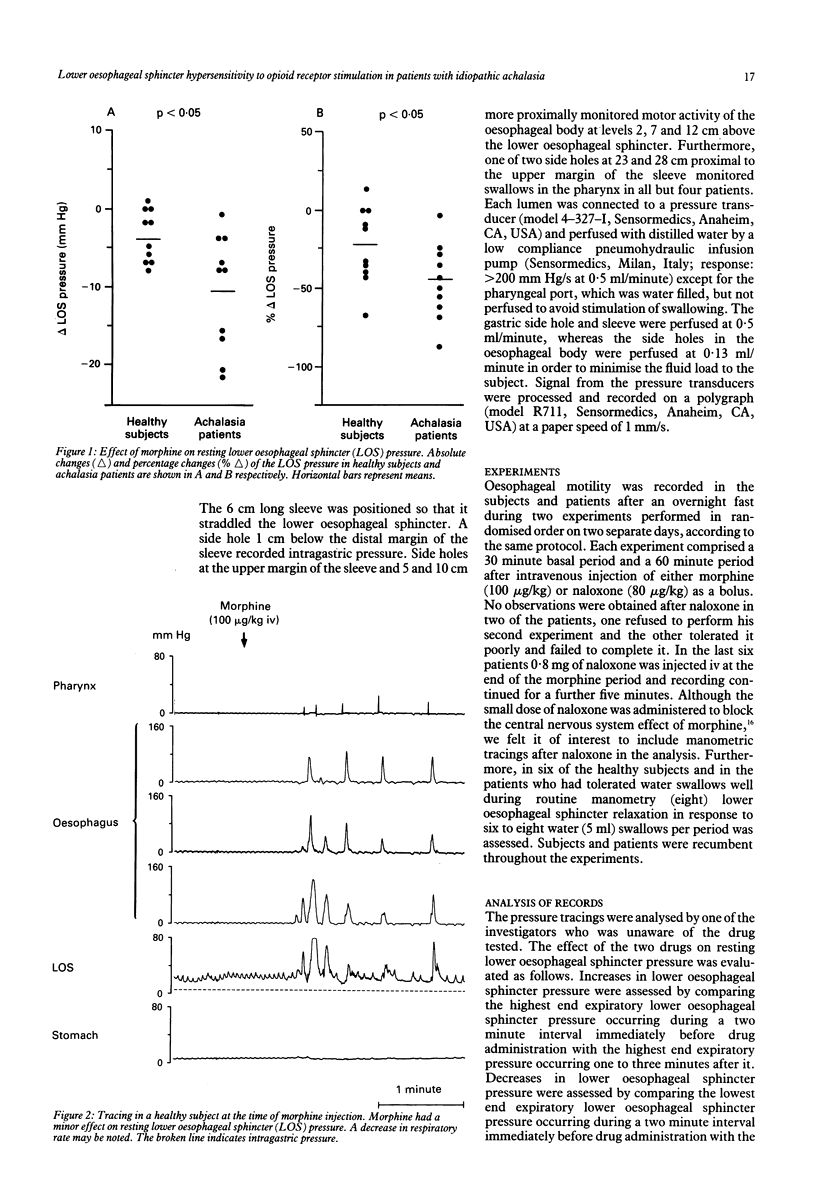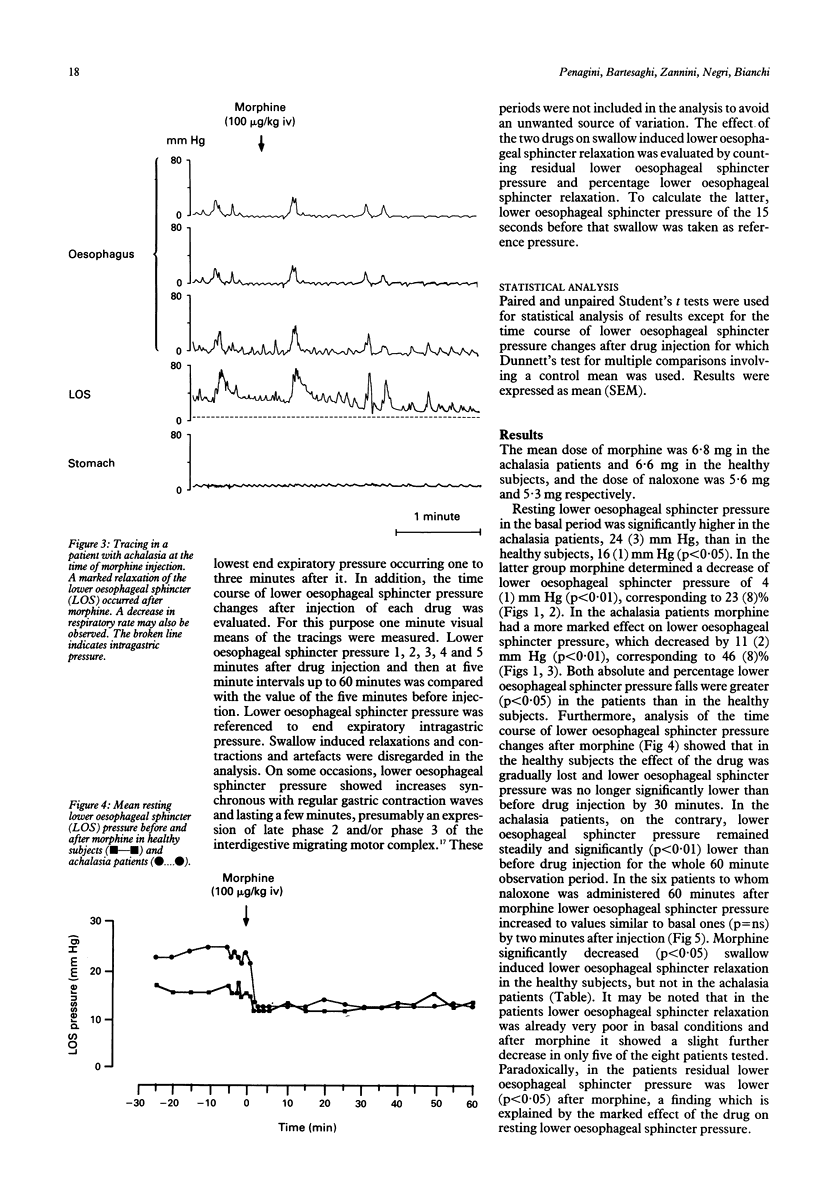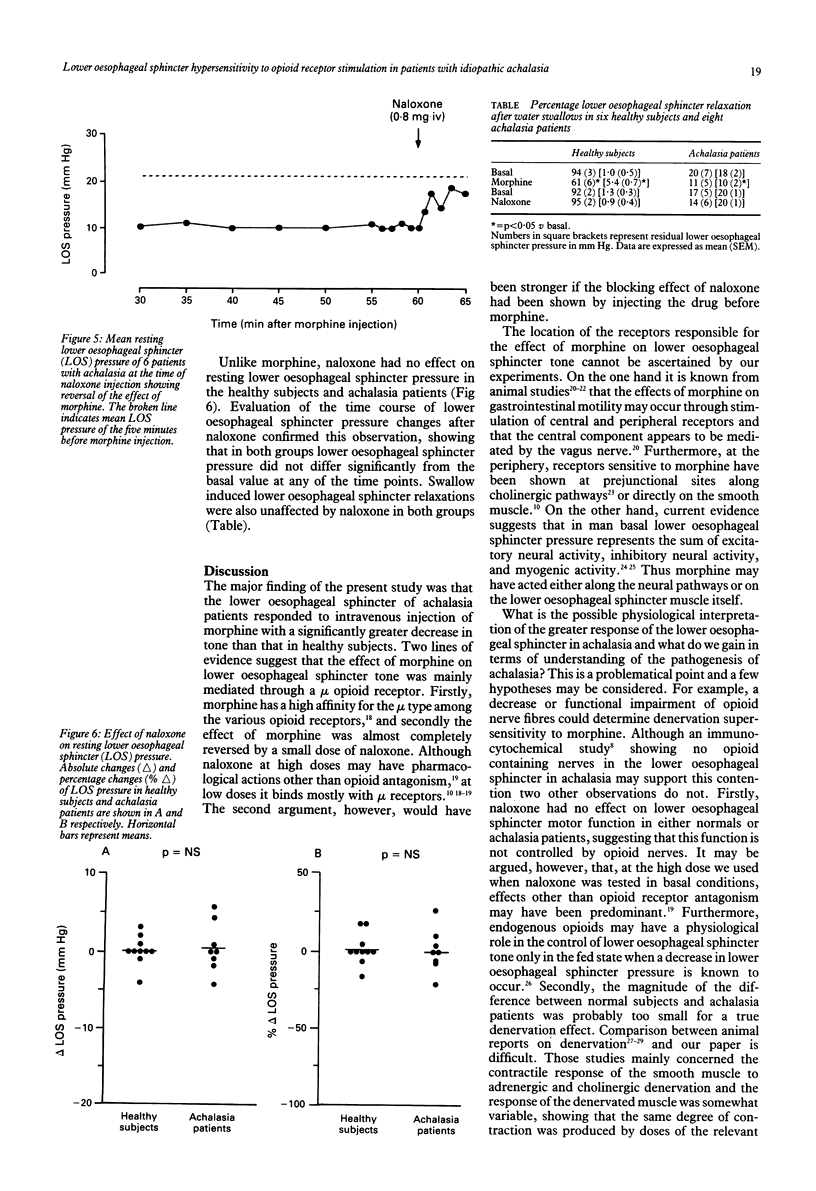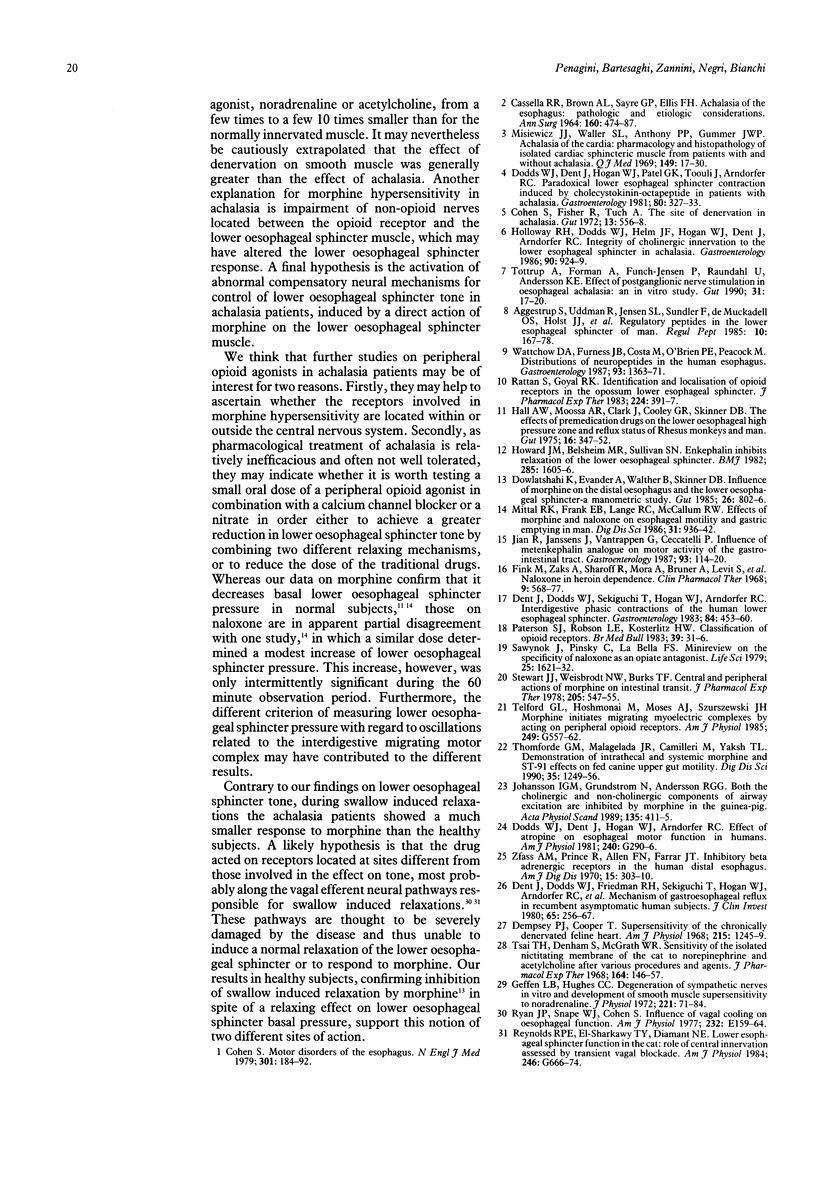Abstract
Impairment of non-cholinergic innervation of the lower oesophageal sphincter has been suggested in idiopathic achalasia. As opioid nerves are present in the lower oesophageal sphincter and opioid peptides affect lower oesophageal sphincter motility, the effect of an opioid agonist, morphine (100 micrograms/kg iv), and an opioid blocker, naloxone (80 micrograms/kg iv), on lower oesophageal sphincter motor function was assessed in 10 healthy subjects and in 10 patients with untreated idiopathic achalasia on separate days and in randomised order. In addition, in six of the patients, naloxone 0.8 mg iv was injected 60 minutes after morphine and recordings continued for a further five minutes. Lower oesophageal sphincter pressure was monitored by a sleeve device. In the healthy subjects morphine decreased (p < 0.01) resting lower oesophageal sphincter pressure by 4 (1) mm Hg (23 (8)%). In the achalasia patients the effect was more marked, lower oesophageal sphincter pressure being reduced (p < 0.01) by 11 (2) mm Hg (46 (8)%). Naloxone reversed lower oesophageal sphincter pressure to basal. Both absolute and percentage decreases after morphine were significantly greater (p < 0.05) in the achalasia patients than in the healthy subjects. Swallow induced lower oesophageal sphincter relaxation was significantly decreased (p < 0.05) by morphine in the healthy subjects but not in the achalasia patients. Naloxone had no effect on resting lower oesophageal sphincter pressure or swallow induced relaxation in either healthy subjects or achalasia patients. In conclusion achalasia patients are hypersensitive to the effect of morphine on resting lower oesophageal sphincter pressure. This finding is unlikely to be the result of a denervation process involving opioid nerves.
Full text
PDF




Selected References
These references are in PubMed. This may not be the complete list of references from this article.
- Aggestrup S., Uddman R., Jensen S. L., Sundler F., Schaffalitzky de Muckadell O., Holst J. J., Håkanson R., Ekman R., Sørensen H. R. Regulatory peptides in the lower esophageal sphincter of man. Regul Pept. 1985 Mar;10(2-3):167–178. doi: 10.1016/0167-0115(85)90011-4. [DOI] [PubMed] [Google Scholar]
- CASSELLA R. R., BROWN A. L., Jr, SAYRE G. P., ELLIS F. H., Jr ACHALASIA OF THE ESOPHAGUS: PATHOLOGIC AND ETIOLOGIC CONSIDERATIONS. Ann Surg. 1964 Sep;160:474–487. doi: 10.1097/00000658-196409000-00010. [DOI] [PMC free article] [PubMed] [Google Scholar]
- Cohen S., Fisher R., Tuch A. The site of denervation in achalasia. Gut. 1972 Jul;13(7):556–558. doi: 10.1136/gut.13.7.556. [DOI] [PMC free article] [PubMed] [Google Scholar]
- Cohen S. Motor disorders of the esophagus. N Engl J Med. 1979 Jul 26;301(4):184–192. doi: 10.1056/NEJM197907263010404. [DOI] [PubMed] [Google Scholar]
- Dempsey P. J., Cooper T. Supersensitivity of the chronically denervated feline heart. Am J Physiol. 1968 Nov;215(5):1245–1249. doi: 10.1152/ajplegacy.1968.215.5.1245. [DOI] [PubMed] [Google Scholar]
- Dent J., Dodds W. J., Friedman R. H., Sekiguchi T., Hogan W. J., Arndorfer R. C., Petrie D. J. Mechanism of gastroesophageal reflux in recumbent asymptomatic human subjects. J Clin Invest. 1980 Feb;65(2):256–267. doi: 10.1172/JCI109667. [DOI] [PMC free article] [PubMed] [Google Scholar]
- Dent J., Dodds W. J., Sekiguchi T., Hogan W. J., Arndorfer R. C. Interdigestive phasic contractions of the human lower esophageal sphincter. Gastroenterology. 1983 Mar;84(3):453–460. [PubMed] [Google Scholar]
- Dodds W. J., Dent J., Hogan W. J., Arndorfer R. C. Effect of atropine on esophageal motor function in humans. Am J Physiol. 1981 Apr;240(4):G290–G296. doi: 10.1152/ajpgi.1981.240.4.G290. [DOI] [PubMed] [Google Scholar]
- Dodds W. J., Dent J., Hogan W. J., Patel G. K., Toouli J., Arndorfer R. C. Paradoxical lower esophageal sphincter contraction induced by cholecystokinin-octapeptide in patients with achalasia. Gastroenterology. 1981 Feb;80(2):327–333. [PubMed] [Google Scholar]
- Dowlatshahi K., Evander A., Walther B., Skinner D. B. Influence of morphine on the distal oesophagus and the lower oesophageal sphincter--a manometric study. Gut. 1985 Aug;26(8):802–806. doi: 10.1136/gut.26.8.802. [DOI] [PMC free article] [PubMed] [Google Scholar]
- Fink M., Zaks A., Sharoff R., Mora A., Bruner A., Levit S., Freedman A. M. Naloxone in heroin dependence. Clin Pharmacol Ther. 1968 Sep-Oct;9(5):568–577. doi: 10.1002/cpt196895568. [DOI] [PubMed] [Google Scholar]
- Geffen L. B., Hughes C. C. Degeneration of sympathetic nerves in vitro and development of smooth muscle supersensitivity to noradrenaline. J Physiol. 1972 Feb;221(1):71–84. doi: 10.1113/jphysiol.1972.sp009739. [DOI] [PMC free article] [PubMed] [Google Scholar]
- Hall A. W., Moossa A. R., Clark J., Cooley G. R., Skinner D. B. The effects of premedication drugs on the lower oesophageal high pressure zone and reflux status of rhesus monkeys and man. Gut. 1975 May;16(5):347–352. doi: 10.1136/gut.16.5.347. [DOI] [PMC free article] [PubMed] [Google Scholar]
- Holloway R. H., Dodds W. J., Helm J. F., Hogan W. J., Dent J., Arndorfer R. C. Integrity of cholinergic innervation to the lower esophageal sphincter in achalasia. Gastroenterology. 1986 Apr;90(4):924–929. doi: 10.1016/0016-5085(86)90869-3. [DOI] [PubMed] [Google Scholar]
- Howard J. M., Belsheim M. R., Sullivan S. N. Enkephalin inhibits relaxation of the lower oesophageal sphincter. Br Med J (Clin Res Ed) 1982 Dec 4;285(6355):1605–1606. doi: 10.1136/bmj.285.6355.1605. [DOI] [PMC free article] [PubMed] [Google Scholar]
- Jians R., Janssens J., Vantrappen G., Ceccatelli P. Influence of metenkephalin analogue on motor activity of the gastrointestinal tract. Gastroenterology. 1987 Jul;93(1):114–120. doi: 10.1016/0016-5085(87)90322-2. [DOI] [PubMed] [Google Scholar]
- Johansson I. G., Grundström N., Andersson R. G. Both the cholinergic and non-cholinergic components of airway excitation are inhibited by morphine in the guinea-pig. Acta Physiol Scand. 1989 Mar;135(3):411–415. doi: 10.1111/j.1748-1716.1989.tb08595.x. [DOI] [PubMed] [Google Scholar]
- Misiewicz J. J., Waller S. L., Anthony P. P., Gummer J. W. Achalasia of the cardia: pharmacology and histopathology of isolated cardiac sphincteric muscle from patients with and without achalasia. Q J Med. 1969 Jan;38(149):17–30. [PubMed] [Google Scholar]
- Mittal R. K., Frank E. B., Lange R. C., McCallum R. W. Effects of morphine and naloxone on esophageal motility and gastric emptying in man. Dig Dis Sci. 1986 Sep;31(9):936–942. doi: 10.1007/BF01303214. [DOI] [PubMed] [Google Scholar]
- Paterson S. J., Robson L. E., Kosterlitz H. W. Classification of opioid receptors. Br Med Bull. 1983 Jan;39(1):31–36. doi: 10.1093/oxfordjournals.bmb.a071787. [DOI] [PubMed] [Google Scholar]
- Rattan S., Goyal R. K. Identification and localization of opioid receptors in the opossum lower esophageal sphincter. J Pharmacol Exp Ther. 1983 Feb;224(2):391–397. [PubMed] [Google Scholar]
- Reynolds R. P., El-Sharkawy T. Y., Diamant N. E. Lower esophageal sphincter function in the cat: role of central innervation assessed by transient vagal blockade. Am J Physiol. 1984 Jun;246(6 Pt 1):G666–G674. doi: 10.1152/ajpgi.1984.246.6.G666. [DOI] [PubMed] [Google Scholar]
- Ryan J. P., Snape W. J., Jr, Cohen S. Influence of vagal cooling on esophageal function. Am J Physiol. 1977 Feb;232(2):E159–E164. doi: 10.1152/ajpendo.1977.232.2.E159. [DOI] [PubMed] [Google Scholar]
- Sawynok J., Pinsky C., LaBella F. S. On the specificity of naloxone as an opiate antagonist. Life Sci. 1979 Nov 5;25(19):1621–1632. doi: 10.1016/0024-3205(79)90403-x. [DOI] [PubMed] [Google Scholar]
- Stewart J. J., Weisbrodt N. W., Burks T. F. Central and peripheral actions of morphine on intestinal transit. J Pharmacol Exp Ther. 1978 Jun;205(3):547–555. [PubMed] [Google Scholar]
- Telford G. L., Hoshmonai M., Moses A. J., Szurszewski J. H. Morphine initiates migrating myoelectric complexes by acting on peripheral opioid receptors. Am J Physiol. 1985 Nov;249(5 Pt 1):G557–G562. doi: 10.1152/ajpgi.1985.249.5.G557. [DOI] [PubMed] [Google Scholar]
- Thomforde G. M., Malagelada J. R., Camilleri M., Yaksh T. L. Demonstration of intrathecal and systemic morphine and ST-91 effects on fed canine upper gut motility. Dig Dis Sci. 1990 Oct;35(10):1249–1256. doi: 10.1007/BF01536415. [DOI] [PubMed] [Google Scholar]
- Tsai T. H., Denham S., McGrath W. R. Sensitivity of the isolated nictitating membrane of the cat to norepinephrine and acetylcholine after various procedures and agents. J Pharmacol Exp Ther. 1968 Nov;164(1):146–157. [PubMed] [Google Scholar]
- Tłottrup A., Forman A., Funch-Jensen P., Raundahl U., Andersson K. E. Effects of postganglionic nerve stimulation in oesophageal achalasia: an in vitro study. Gut. 1990 Jan;31(1):17–20. doi: 10.1136/gut.31.1.17. [DOI] [PMC free article] [PubMed] [Google Scholar]
- Wattchow D. A., Furness J. B., Costa M., O'Brien P. E., Peacock M. Distributions of neuropeptides in the human esophagus. Gastroenterology. 1987 Dec;93(6):1363–1371. doi: 10.1016/0016-5085(87)90267-8. [DOI] [PubMed] [Google Scholar]
- Zfass A. M., Prince R., Allen F. N., Farrar J. T. Inhibitory beta adrenergic receptors in the human distal esophagus. Am J Dig Dis. 1970 Apr;15(4):303–310. doi: 10.1007/BF02239282. [DOI] [PubMed] [Google Scholar]


